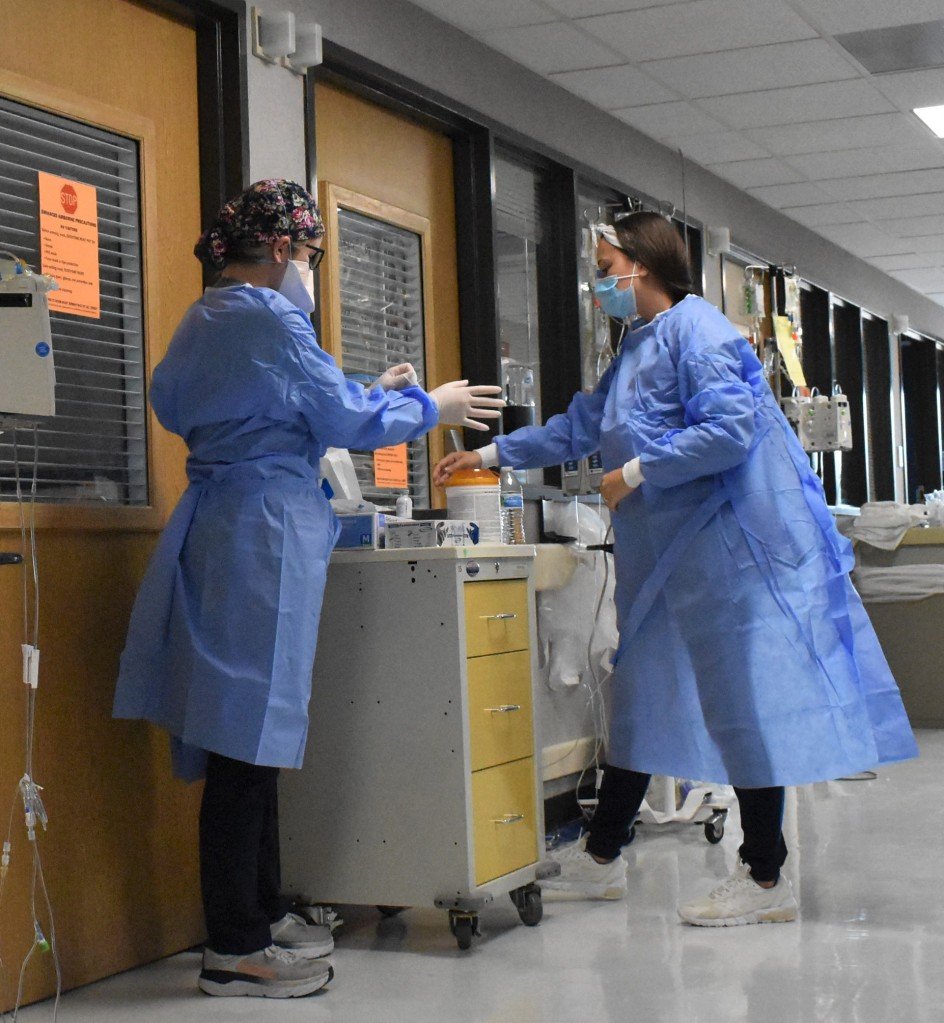By Michael Kinney
LAWTON– Dylan Humphrey doesn’t get many nights off, so when he does, he tries to relax. But that has become harder the past couple of months.
Recently, while enjoying a night off from his job as House Supervisor at Comanche County Memorial Hospital, Humphrey got called into work. When he arrived, he was caught off-guard by what awaited him in the intensive care unit (ICU).
“I got here and I said give me a minute and I’ll come down,” Humphrey said. “I come down to the ICU and they were coding three Covid patients at the same time with just seven nurses. You probably need 10 or 12 for one code. It’s just overwhelming not being able to do anything about it. Nothing you can do. They are just dying.”
According to Humphrey, that’s when many of them finally relent and ask for the COVID-19 vaccine that they had been putting off or vowing never to take.
“But, it’s too late,” Humphrey said.

At that moment Humphrey watched the ICU doctors and nurses were working to save the life of a 59-year-old unvaccinated man. Unfortunately, after a couple of hours he died, the second that day.
CCMH is one of the many hospitals across Oklahoma and the rest of the nation that has been overwhelmed by the recent COVID-19 surge. Led by the delta variant, the pandemic that seemed to be waning in the early summer months has now come back stronger and more lethal, according to Dr. Scott Michener, Chief Medical Officer at CCMH.
“It’s different. It’s a different virus. The game has changed,” Michener said. “It’s more contagious. It’s more common and so easy to catch. It’s just kind of everywhere.”
What has also made this recent surge different is that the COVID patients are getting younger. Instead of seeing the elderly, hospitals are admitting men and women in their 40s and 50s. Sometimes even younger.
“It’s been depressing because we’re going to have to do it again,” said ICU charge nurse Karen Lawton, who has been in the ICU for almost three decades. “We had made great progress and it’s coming back. We thought maybe we were doing OK because it took a little while to get to us. But it’s back and we’re seeing younger people, sicker people and people who haven’t been vaccinated.
“I’ve taken more people to the morgue the last 18 months than I have my entire career.”
Out of 29 patients at CCMH who had COVID-19 on Aug. 19, 26 of them were unvaccinated and all in the ICU or ER. The three who were vaccinated had only mild symptoms.
Hospital officials contend the only way to combat the COVID-19 surge is to get as many people vaccinated as possible. However, that has proven a tougher task than expected.
Oklahoma has a statewide vaccination rate of just 41.9%. That ranks as the 11th lowest in the nation.
CCMH is the biggest hospital in Comanche County, which has a population of more than 124,000. However, as of Aug. 20, only 40% of the county has been fully vaccinated. That puts it as the eighth highest in the state. Cimarron County is last at 21.24%.
Oklahoma County (49%) and Tulsa County (47%), the two biggest in the state, have the highest vaccination rates, but have yet to reach half their available residents.
“More than 90% of all patients who come to us hoping that we can save them, help them breathe again, stop their kidneys from failing from COVID, haven’t taken the vaccine,” said Dr. Julie Watson, chief medical officer at INTEGRIS Health. “Some 93% of Oklahomans who have been hospitalized in the last month with COVID have not had the vaccine. These patients believe in us when they are sick but seemingly haven’t trusted us when we’ve shared with them how to stay well. It is heartbreaking and exhausting.”
The lack of Oklahoma residents willing to get the vaccine has become frustrating and disappointing for hospital workers. That includes the 32% of workers at CCMH who remained unvaccinated as of Aug. 20.
“I just don’t get it. People don’t have empathy for other people,” Michener said. “So when you say the nurses are stressed out, the ICU’s full, the ER is full, they don’t think it pertains to them so they say ‘(Forget) it. It isn’t going to happen to me.’ That’s what they think.”
Michener pointed out that those who remain unvaccinated and then get infected COVID-19, have a chance to just hurt their neighbors and community members. The strain the unvaccinated are putting on the healthcare system has forced some hospitals discontinue non-emergent or elective procedures.
Michener has seen it up close with several patients who have been unable to get needed treatments because of the lack of staff or available beds in Oklahoma hospitals.
“One of my few emergencies was testicular torsion. That’s where the testicles spin inside the scrotum. If one spins, it cuts the blood supply off. Just like a kink in a garden hose. You have about six hours to unspin it to save the testicles,” a frustrated Michener said. “So this kid goes to Cordell (Memorial Hospital), they do not have a urologist. They call everywhere. Everyone is on divert. Nobody has a bed. So they send him home with pain medicine. The next day he shows up at the (Lawton) Indian Hospital. They do an ultrasound and confirm there is no blood flow to his testicles. Now he is 30 hours out. So you have a 16-year-old kid who loses one of his testicles because everyone is full. So it’s real.”
CCMH is also one of the facilities that is dealing with a severe shortage of nurses. According to Humphrey, they are operating with a 33% smaller staff than normal.
Many small and mid-sized hospitals have seen nurses leave to take jobs as travel nurses in other states that are in desperate need of health care workers. Some hospitals have advertised paying as much as $200 to $225 an hour (before overtime) for a qualified RN.
“We are short on staff,” Lawton said. “We have an ICU on the other side and it’s not open right now because we don’t have enough nurses. A lot of our nurses have left to go work nursing contracts, so we don’t have the staff.”
As the country heads into the fall and winter months, officials or predicting the situation to get worse. The introduction of new COVID-19 variants Lambda and B.1.621 is concerning and something the World Health Organization is keeping an eye on.
Another worry is the fact that the delta variant is striking the young in a way that the original virus never did. And with school having started or set to start around the country, it could lead to a serious situation, especially since children under 12 have not been approved for any of the vaccines yet.
Oklahoma is one of at least eight states that has laws on the books that ban mask mandates at school districts unless the governor declares a state of emergency. It went into effect July 1.
But according to Michener, everyone is going to have to deal with the COVID-19 virus at some point. He says there will be no escape from it, but they can choose how severe it will be on them.
“They are choosing COVID instead of choosing the vaccine. It’s not going to go away. You and I aren’t going to talk in December and it’s going to have magically disappeared. That’s not the way it works,” Michener said. “I think making people see the end game and the end game is, everybody is going to get it. Maybe not get it badly, but I think we’re all going to get it. It’s either going to happen to them one way or the other.”
Story & Photos by Michael Kinney
Copyright Michael Kinney Media


